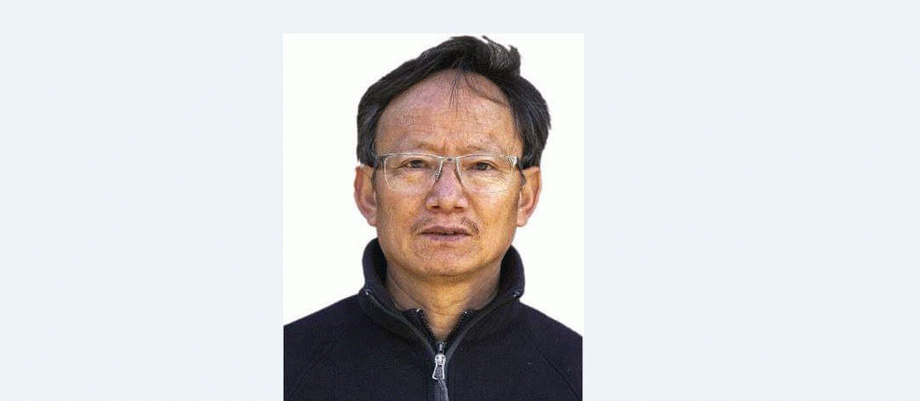In Conversation with Dr. Motup Dorje, Chief Medical Officer

Q. Brief us about the Health Department of Leh district. What are the roles and function?
Health department responsibility is to provide complete health care facilities in the whole district. In health, there are three major components including, Preventive, Promotive, and Curative. Preventive care is primary prevention of occurrence of a disease which is infectious and also non-communicable diseases. Examples include vaccination against diseases, maintaining a healthy diet and exercise regimen for young adults and avoiding smoking. We need to concentrate more on non-communicable diseases such as heart attacks, diabetes, cancer, etc. In promotive health, effort is made to reduce the impact of the diseases, enabling people to increase their control over own health. In curative, specific medical treatment and therapies is provided to a patient to improve or eliminate symptoms.
Overall, the department roles and responsibility is to reduce the morbidity of different diseases prevailing in the district, to provide better treatment facilities, control, and prevention of communicable diseases, imparting health education, etc.
Q. How many medical health centres, PHCs and sub-district hospitals are catering health care in the entire district?
In Leh district, there are 177 institutions including 1 district hospital (SNM) in Leh, 1 Sub-district hospital in Nubra, 1 Community Health Centre in Skurbuchan, 14 Primary Health centres, 3 new types of Primary Health centre and 158 sub-centres are catering in different villages.
Q. Talking about public health issues, we have witnessed that many of the patients are diagnosed late when referred to a big hospital outside states. What is the reason behind and how it can be curbed?
Late diagnosis of the disease is mainly because of the lack of awareness among people about the signs and symptoms of the disease and referring to the health centre late.
Awareness of various diseases, its signs and symptoms, availability of treatment and early prevention needs to be imparted. There are many health programs such as the National Health Program, National Health Mission and many others to ensure awareness, screening, and treatment. We organise health education program frequently in every part of the district to educate people.
Q. What are the plans and measures taken to provide better health facilities?
Talking about the health facilities, I am more worried about the urban areas for now as compared to rural areas because the population of the town is increasing every year. Around 30,000 population living within the periphery of Leh town are uncovered. In villages, even the smallest population area has health centres or community health worker trained by the department.
Under Public Sector Undertaking, MRI machine for SNM hospital got sanction, ₹2.4 crore for PHC’s. We will be equipping Diskit sub-district hospital and Khaltse with digital x-ray and ultrasound machine. Changthang area is covered under the special program of the Ministry of Home Affairs under which there is a provision of medicine and equipment. Hopefully, we will get this year.
Q. Do we have any plans and policy regarding health issues like referrals, health insurance, and preventive healthcare of diseases like cancer, heart disease, and future disease trends?
Non-communicable diseases such as Heart attacks, mental health, diabetes are becoming a matter of concern nowadays. Different programs such as National Programme for Health Care of the Elderly (NPHCE), National Programme for Prevention and Control of Cancer, Diabetes, Cardiovascular Diseases and Stroke (NPCDCS), National Dialysis program is launched focusing on the health promotion, early diagnosis, management, and referral of cases, besides strengthening the infrastructure and capacity building. Also, we have a mobile medical unit which moves to two different places in a month.
Q. Tell us about the training and exposure provided to the personnel to improve health care at all levels.
Training is held every month in every block also at district, state and national level. With the help of NGO, training is imparted to the gynaecologist to screen and diagnose cervical cancer. Training and exposure to health care workers at all level is an ongoing process.
Q. What are the different Government schemes and benefit provided for the people and how to avail it?
The government is focusing more on mother and child health for which a national programme named Janani Suraksha Yojana (JSY) and Janani Shishu Suraksha Karyakaram (JSSK) are provided. Under JSY, all pregnant women are paid incentives of ₹1000 to the urban areas and 1,400 to the rural areas after delivery. In JSSK, the pregnant mother admitted in the hospital is provided free medicines, diagnostic, diet, and referral transport. Likewise, children under one year are also included under the programme. Also, there is a programme named free drugs and diagnostic under which there is a list of drugs and diagnostic which are made available to the people for free.
Pradhan Mantri Jan Arogya Yojana (PM-JAY): Under this, families as per the Socio-Economic Caste Census (SECC) data will be offered a benefit cover of ₹500,000 per family per year to cover medical and hospitalization expenses. People who are included in the SECC data of 2012 can apply for a golden card through which one can avail the benefit from any empanelled hospitals.
Ayushman Bharat - Health and Wellness Centres: Under this programme, Sub Health Centres and Primary Health Centres are strengthened as Health and wellness centre. Free medicines, basic equipment, child health services, medicines and care for communicable and non-communicable diseases, emergency care are provided.
Message to the reader
Health workers are definitely there to provide every care and assistance but along with it, we need cooperation and responsibility to improve the health sector.





